应用语言学课程总结
语用学课后总结
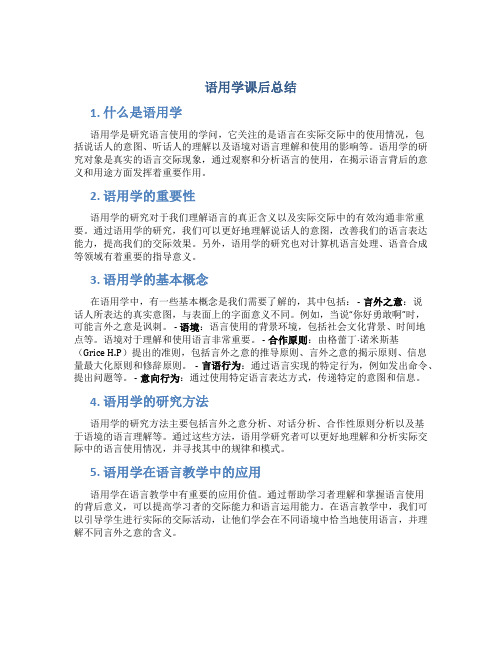
语用学课后总结1. 什么是语用学语用学是研究语言使用的学问,它关注的是语言在实际交际中的使用情况,包括说话人的意图、听话人的理解以及语境对语言理解和使用的影响等。
语用学的研究对象是真实的语言交际现象,通过观察和分析语言的使用,在揭示语言背后的意义和用途方面发挥着重要作用。
2. 语用学的重要性语用学的研究对于我们理解语言的真正含义以及实际交际中的有效沟通非常重要。
通过语用学的研究,我们可以更好地理解说话人的意图,改善我们的语言表达能力,提高我们的交际效果。
另外,语用学的研究也对计算机语言处理、语音合成等领域有着重要的指导意义。
3. 语用学的基本概念在语用学中,有一些基本概念是我们需要了解的,其中包括: - 言外之意:说话人所表达的真实意图,与表面上的字面意义不同。
例如,当说“你好勇敢啊”时,可能言外之意是讽刺。
- 语境:语言使用的背景环境,包括社会文化背景、时间地点等。
语境对于理解和使用语言非常重要。
- 合作原则:由格蕾丁·诺米斯基(Grice H.P)提出的准则,包括言外之意的推导原则、言外之意的揭示原则、信息量最大化原则和修辞原则。
- 言语行为:通过语言实现的特定行为,例如发出命令、提出问题等。
- 意向行为:通过使用特定语言表达方式,传递特定的意图和信息。
4. 语用学的研究方法语用学的研究方法主要包括言外之意分析、对话分析、合作性原则分析以及基于语境的语言理解等。
通过这些方法,语用学研究者可以更好地理解和分析实际交际中的语言使用情况,并寻找其中的规律和模式。
5. 语用学在语言教学中的应用语用学在语言教学中有重要的应用价值。
通过帮助学习者理解和掌握语言使用的背后意义,可以提高学习者的交际能力和语言运用能力。
在语言教学中,我们可以引导学生进行实际的交际活动,让他们学会在不同语境中恰当地使用语言,并理解不同言外之意的含义。
6. 语用学的发展趋势随着社会的变化和科技的发展,语用学也在不断发展和演进。
应用语言学总结
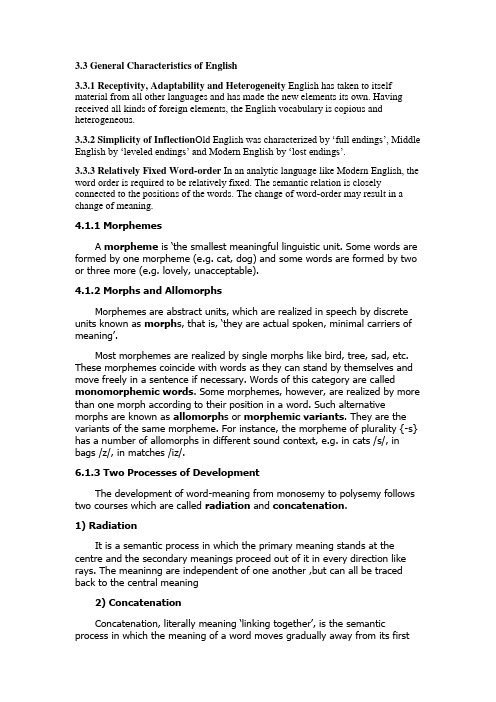
3.3 General Characteristics of English3.3.1 Receptivity, Adaptability and Heterogeneity English has taken to itself material from all other languages and has made the new elements its own. Having received all kinds of foreign elements, the English vocabulary is copious and heterogeneous.3.3.2 Simplicity of Inflection Old English was characte rized by ‘full endings’, Middle English by ‘leveled endings’ and Modern English by ‘lost endings’.3.3.3 Relatively Fixed Word-order In an analytic language like Modern English, the word order is required to be relatively fixed. The semantic relation is closely connected to the positions of the words. The change of word-order may result in a change of meaning.4.1.1 MorphemesA morpheme is …the smallest meaningful linguistic unit. Some words are formed by one morpheme (e.g. cat, dog) and some words are formed by two or three more (e.g. lovely, unacceptable).4.1.2 Morphs and AllomorphsMorphemes are abstract units, which are realized in speech by discrete units known as morph s, that is, …they are actual spoken, minimal carriers of meaning‟.Most morphemes are realized by single morphs like bird, tree, sad, etc. These morphemes coincide with words as they can stand by themselves and move freely in a sentence if necessary. Words of this category are called monomorphemic words. Some morphemes, however, are realized by more than one morph according to their position in a word. Such alternative morphs are known as allomorph s or morphemic variants. They are the variants of the same morpheme. For instance, the morpheme of plurality {-s} has a number of allomorphs in different sound context, e.g. in cats /s/, in bags /z/, in matches /iz/.6.1.3 Two Processes of DevelopmentThe development of word-meaning from monosemy to polysemy follows two courses which are called radiation and concatenation.1) RadiationIt is a semantic process in which the primary meaning stands at the centre and the secondary meanings proceed out of it in every direction like rays. The meaninng are independent of one another ,but can all be traced back to the central meaning2) ConcatenationC oncatenation, literally meaning …linking together‟, is the semantic process in which the meaning of a word moves gradually away from its firstsignification by successive shifts of meanings until, in many cases, there is not a shadow of connection between the sense that is finally developed and that which the term had in it at the outset .Unlike radiation where each of the derived meaning is directly connected to the primary meaning,Concatenation describes a process where each of the later meaning is related only to the preceding one like chains.Radiation is concatenation is closely related, being different stages of the development leadingto polysemy..The two processes work together, complementing each other.(2) AffixesAffixes are linguistic fragments that are attached to words or word elements to modify meaning or change function. According to the functions of affixes, we can put them into two groups: inflectional and derivational affixes.a. Inflectional AffixesThey are affixes attached to the end of words to indicate grammatical relationships, e.g. the regular plural suffix –s (-es); the past tense marker –ed. The number of inflectional affixes is small and stable, which makes English one of the easiest languages to learn.b. Derivational AffixesThey are affixes added to other morphemes to derive new words. They can be further divided into prefixes and suffixes. Prefixes occur before the word and the suffixes after the word.7.1 Types of Meaning Changeextension, narrowing, elevation, degradation, transference, and euphemism.7.1.1 Extension of meaningExtension of meaning, also known as generalization, is the name given to the widening of meaning which some words undergo. It is a process by which a word which originally had a specialized meaning has now become generalized or has extended to cover a broader and often less definite concept, e.g. manuscript7.1.2 Narrowing of MeaningNarrowing of meaning, also called specialization, is the opposite of widening meaning. It is a process by which a word of wide meaning acquires a narrower or specialized sense. In other words, a word which used to have a more general sense becomes restricted in its application and conveys a special concept in present-day English, e.g. garage7.1.3 Elevation of meaningElevation or amelioration refers to the process by which words rise from humble beginnings to positions of importance, e.g. nice7.1.4 Degradation of MeaningDegradation or pejoration of meaning is the opposite of semantic elevation. It is a process whereby words of good origin or affective neutrality fall into ill reputation or come to be used in a derogatory sense, e.g. boor7.1.5 Transference of MeaningSome words which were used to designate one thing but later changed to mean something else have experienced the process of semantic transfer, known as transference or transfer of meaning. E.g. paper.1)Associated TransferIt is what is commonly known as figurative extension of meaning.2)Transfer between Abstract and Concrete MeaningsRoom formerly meant …space‟ as in “There is no room in the car”. Now it has developed a concrete meaning as in “This flat has three rooms”.3)Transfer between Subjective and Objective MeaningsSome words were formerly used subjectively but later shifted to an objective use, and the subjective meaning was totally lost, e.g. pitiful.4)SynesthesiaThis kind of transfer takes place between words of sensation. That is, words usually associated with one sense are used to describe another sense, e.g. clear-sounding (from sight to hearing).1.The most common types of word-meaning changes are extension and n_________.(narrowing) 2. Extension of meaning, also known as g________, is the name given to the widening of meaning which some words undergo. (generalization) 3. The associated transfer of meaning and euphemistic use of words etc. are often due to p_________.(psychological factors) 4. Narrowing of meaning is the opposite of e_______meaning.(extension) 5. Words which were uesd to designate one thing but later changed tomean something else have experienced the process of semantic t________. (transfer) 6.Changes of word meaning are due to linguistic factors and e_____factors. (extra-linguistic) 7. Linguistic factors includes internal factors within the language system, the influx of borrowings and (analogy)2.nonresistance, irregular, illogical, unnecessary, impolite, dishonest3.misjudge, misunderstand anti-Japanese, counter-revolution4.-less: endless, selfless, careless5.-en: golden6.-ern: eastern, western7.-able: comfortable, suitable8.-ish: childish, foolish, bookish9.-al: national, cultural10.-ant: significant, pollutant11.-ent: different, independent12.-ous: famous, courageous13.-y: cloudy, rainy, windy14.-ic: heroic,democratic Movable comfortable applicable visible responsible Natural additional educational physicalRepublicanMerciful tactful graceful dutifulMokeyish snobbish nightmarish sixtyish wettish thinnish plum pishPriceless timelessDreamlike animallike ladylike15.bus=omnibus plane=aeroplane mod=modern demo=demonstrationad=advertisement flu=influenza tec=detective16.。
应用语言学

应用语言学应用语言学是从语言学学科中发展而来的一门研究语言应用的学科。
它主要关注语言在实际生活中的应用和实际使用中的语言现象。
这门学科的研究对象包括语言的使用、语言的变化、语言的规范、语言的习得等方面,研究语言的实际应用场景,为实际生活中的语言问题提供解决方案和建议。
在应用语言学的研究中,语言的应用分成听力、口语、阅读和写作四个方面进行研究。
其中,口语是最为重要的一方面,因为语言首先是一种口头交流的工具。
基于这个原因,口语研究也是应用语言学的重点。
在口语研究中,应用语言学家主要关注的是语音、语调、语音连读、语法、词汇及交际方式等方面。
应用语言学的研究内容以及其在实践中的应用非常广泛,下面将从以下两个方面阐述应用语言学的研究内容和实践应用:一、应用语言学的研究内容1. 语言习得语言习得是指儿童从自然环境中通过交际学习掌握语言的过程。
一些应用语言学家从实践角度出发,研究儿童语言习得的规律,以便更好地帮助成年人学习语言。
2. 语言交际语言交际是指对话中的交互过程,其中包括说话者的使用能力,理解能力,反应时间等因素。
应用语言学家研究这些因素的作用,以便更好地帮助人们在实际交际中获得更好的体验。
3. 语言习惯语言习惯是指人们在某些社会情境中使用特定的语言习惯,如礼仪用语、非正式语言等。
应用语言学家研究这些习惯的变化,以便更好地帮助人们理解和使用不同的习惯。
4. 语言变种语言变种是指在不同地区、不同群体、不同年龄段、不同文化背景中使用的不同变体。
应用语言学家研究这些变体,以便更好地帮助人们跨越不同的文化和社会背景。
二、应用语言学的实践应用1. 教学应用应用语言学的教学应用主要是帮助人们更好地学习语言。
利用应用语言学的研究成果,教师可以合理地设计教材和课程,满足学生的不同需求,提高学生语言运用的能力。
例如,在英语教学中,应用语言学家研究了学生在听力和口语方面的需求和问题,因此,他们会在设计教材和课程时针对这些需求进行设计。
语言学应用基础知识点总结
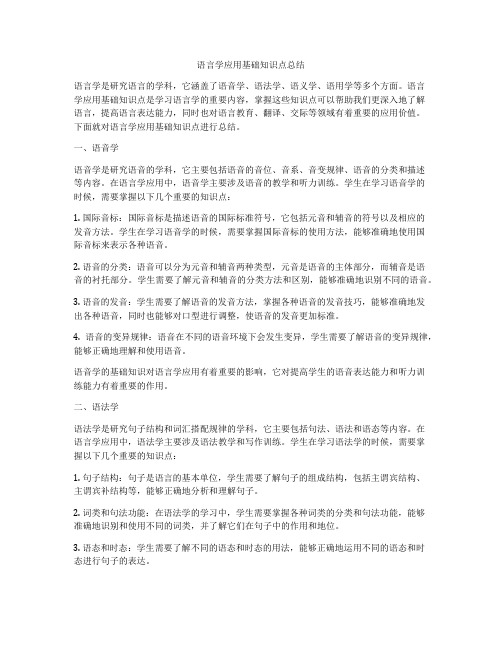
语言学应用基础知识点总结语言学是研究语言的学科,它涵盖了语音学、语法学、语义学、语用学等多个方面。
语言学应用基础知识点是学习语言学的重要内容,掌握这些知识点可以帮助我们更深入地了解语言,提高语言表达能力,同时也对语言教育、翻译、交际等领域有着重要的应用价值。
下面就对语言学应用基础知识点进行总结。
一、语音学语音学是研究语音的学科,它主要包括语音的音位、音系、音变规律、语音的分类和描述等内容。
在语言学应用中,语音学主要涉及语音的教学和听力训练。
学生在学习语音学的时候,需要掌握以下几个重要的知识点:1. 国际音标:国际音标是描述语音的国际标准符号,它包括元音和辅音的符号以及相应的发音方法。
学生在学习语音学的时候,需要掌握国际音标的使用方法,能够准确地使用国际音标来表示各种语音。
2. 语音的分类:语音可以分为元音和辅音两种类型,元音是语音的主体部分,而辅音是语音的衬托部分。
学生需要了解元音和辅音的分类方法和区别,能够准确地识别不同的语音。
3. 语音的发音:学生需要了解语音的发音方法,掌握各种语音的发音技巧,能够准确地发出各种语音,同时也能够对口型进行调整,使语音的发音更加标准。
4. 语音的变异规律:语音在不同的语音环境下会发生变异,学生需要了解语音的变异规律,能够正确地理解和使用语音。
语音学的基础知识对语言学应用有着重要的影响,它对提高学生的语音表达能力和听力训练能力有着重要的作用。
二、语法学语法学是研究句子结构和词汇搭配规律的学科,它主要包括句法、语法和语态等内容。
在语言学应用中,语法学主要涉及语法教学和写作训练。
学生在学习语法学的时候,需要掌握以下几个重要的知识点:1. 句子结构:句子是语言的基本单位,学生需要了解句子的组成结构,包括主谓宾结构、主谓宾补结构等,能够正确地分析和理解句子。
2. 词类和句法功能:在语法学的学习中,学生需要掌握各种词类的分类和句法功能,能够准确地识别和使用不同的词类,并了解它们在句子中的作用和地位。
应用语言学导论课程总结
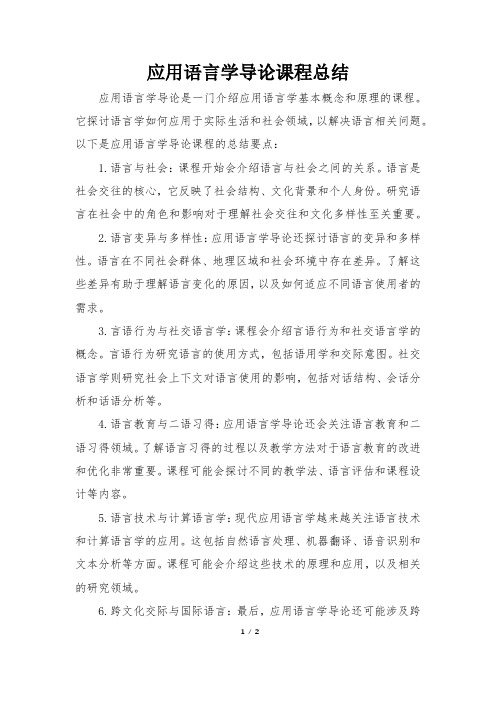
应用语言学导论课程总结应用语言学导论是一门介绍应用语言学基本概念和原理的课程。
它探讨语言学如何应用于实际生活和社会领域,以解决语言相关问题。
以下是应用语言学导论课程的总结要点:1.语言与社会:课程开始会介绍语言与社会之间的关系。
语言是社会交往的核心,它反映了社会结构、文化背景和个人身份。
研究语言在社会中的角色和影响对于理解社会交往和文化多样性至关重要。
2.语言变异与多样性:应用语言学导论还探讨语言的变异和多样性。
语言在不同社会群体、地理区域和社会环境中存在差异。
了解这些差异有助于理解语言变化的原因,以及如何适应不同语言使用者的需求。
3.言语行为与社交语言学:课程会介绍言语行为和社交语言学的概念。
言语行为研究语言的使用方式,包括语用学和交际意图。
社交语言学则研究社会上下文对语言使用的影响,包括对话结构、会话分析和话语分析等。
4.语言教育与二语习得:应用语言学导论还会关注语言教育和二语习得领域。
了解语言习得的过程以及教学方法对于语言教育的改进和优化非常重要。
课程可能会探讨不同的教学法、语言评估和课程设计等内容。
5.语言技术与计算语言学:现代应用语言学越来越关注语言技术和计算语言学的应用。
这包括自然语言处理、机器翻译、语音识别和文本分析等方面。
课程可能会介绍这些技术的原理和应用,以及相关的研究领域。
6.跨文化交际与国际语言:最后,应用语言学导论还可能涉及跨1/ 2文化交际和国际语言的研究。
全球化时代,不同文化之间的交流和理解变得越来越重要。
了解跨文化交际的原则和国际语言的使用对于促进跨文化交流和解决语言障碍具有重要意义。
2/ 2。
应用语言学总结(自写)
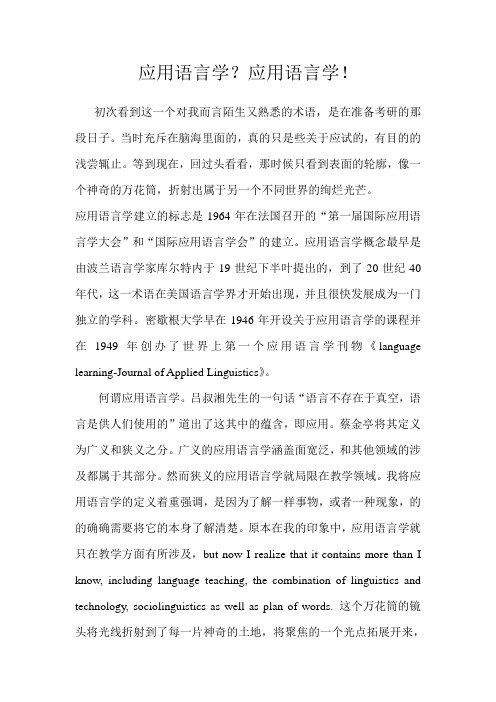
应用语言学?应用语言学!初次看到这一个对我而言陌生又熟悉的术语,是在准备考研的那段日子。
当时充斥在脑海里面的,真的只是些关于应试的,有目的的浅尝辄止。
等到现在,回过头看看,那时候只看到表面的轮廓,像一个神奇的万花筒,折射出属于另一个不同世界的绚烂光芒。
应用语言学建立的标志是1964年在法国召开的“第一届国际应用语言学大会”和“国际应用语言学会”的建立。
应用语言学概念最早是由波兰语言学家库尔特内于19世纪下半叶提出的,到了20世纪40年代,这一术语在美国语言学界才开始出现,并且很快发展成为一门独立的学科。
密歇根大学早在1946年开设关于应用语言学的课程并在1949年创办了世界上第一个应用语言学刊物《language learning-Journal of Applied Linguistics》。
何谓应用语言学。
吕叔湘先生的一句话“语言不存在于真空,语言是供人们使用的”道出了这其中的蕴含,即应用。
蔡金亭将其定义为广义和狭义之分。
广义的应用语言学涵盖面宽泛,和其他领域的涉及都属于其部分。
然而狭义的应用语言学就局限在教学领域。
我将应用语言学的定义着重强调,是因为了解一样事物,或者一种现象,的的确确需要将它的本身了解清楚。
原本在我的印象中,应用语言学就只在教学方面有所涉及,but now I realize that it contains more than I know, including language teaching, the combination of linguistics and technology, sociolinguistics as well as plan of words. 这个万花筒的镜头将光线折射到了每一片神奇的土地,将聚焦的一个光点拓展开来,散射金光。
应用语言学的理论主要包括了行为主义理论,心灵主义理论,对比分析和错误分析,输入假设理论等,这些理论作为支撑,再加上独特的研究方法(定性分析,定量分析以及近几年流行起来的语料库方法和微变化方法),使得应用语言学日趋繁荣。
应用语言学教学实践(3篇)
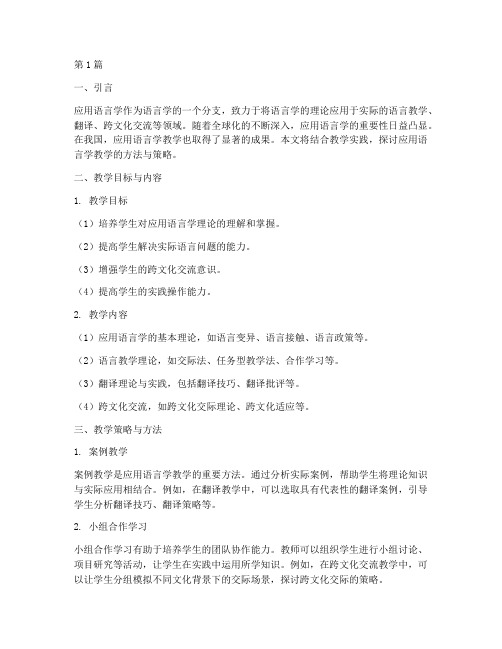
第1篇一、引言应用语言学作为语言学的一个分支,致力于将语言学的理论应用于实际的语言教学、翻译、跨文化交流等领域。
随着全球化的不断深入,应用语言学的重要性日益凸显。
在我国,应用语言学教学也取得了显著的成果。
本文将结合教学实践,探讨应用语言学教学的方法与策略。
二、教学目标与内容1. 教学目标(1)培养学生对应用语言学理论的理解和掌握。
(2)提高学生解决实际语言问题的能力。
(3)增强学生的跨文化交流意识。
(4)提高学生的实践操作能力。
2. 教学内容(1)应用语言学的基本理论,如语言变异、语言接触、语言政策等。
(2)语言教学理论,如交际法、任务型教学法、合作学习等。
(3)翻译理论与实践,包括翻译技巧、翻译批评等。
(4)跨文化交流,如跨文化交际理论、跨文化适应等。
三、教学策略与方法1. 案例教学案例教学是应用语言学教学的重要方法。
通过分析实际案例,帮助学生将理论知识与实际应用相结合。
例如,在翻译教学中,可以选取具有代表性的翻译案例,引导学生分析翻译技巧、翻译策略等。
2. 小组合作学习小组合作学习有助于培养学生的团队协作能力。
教师可以组织学生进行小组讨论、项目研究等活动,让学生在实践中运用所学知识。
例如,在跨文化交流教学中,可以让学生分组模拟不同文化背景下的交际场景,探讨跨文化交际的策略。
3. 情景模拟情景模拟是提高学生实际操作能力的重要手段。
教师可以设计各种情景,让学生在模拟情境中运用所学知识。
例如,在语言教学实践中,可以模拟真实的教学场景,让学生扮演教师和学生的角色,体验教学过程。
4. 多媒体教学多媒体教学可以丰富教学内容,提高学生的学习兴趣。
教师可以利用PPT、视频、音频等多种媒体形式,展示教学内容,增强教学的直观性和趣味性。
5. 实践教学实践教学是应用语言学教学的关键环节。
教师可以组织学生参加实习、志愿者活动等,让学生在实践中检验所学知识。
例如,在翻译教学中,可以组织学生参与志愿者翻译活动,提高学生的翻译实践能力。
应用语言学复习总结
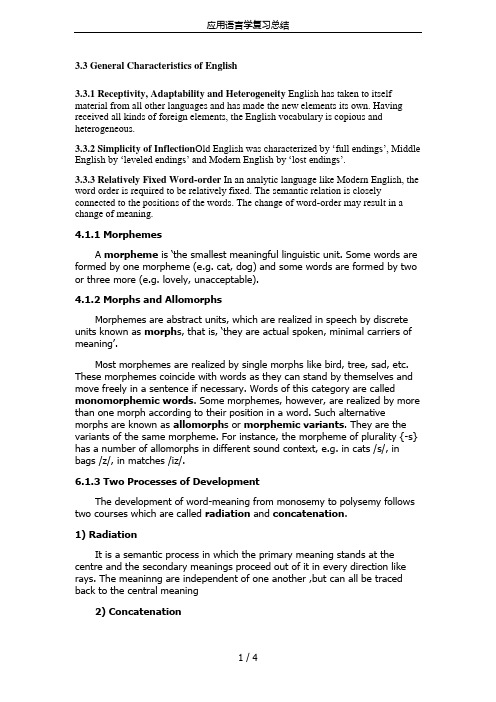
3.3 General Characteristics of English3.3.1 Receptivity, Adaptability and Heterogeneity English has taken to itself material from all other languages and has made the new elements its own. Having received all kinds of foreign elements, the English vocabulary is copious and heterogeneous.3.3.2 Simplicity of Inflection Old English was characte rized by ‘full endings’, Middle English by ‘leveled endings’ and Modern English by ‘lost endings’.3.3.3 Relatively Fixed Word-order In an analytic language like Modern English, the word order is required to be relatively fixed. The semantic relation is closely connected to the positions of the words. The change of word-order may result in a change of meaning.4.1.1 MorphemesA morpheme is ‘the smallest meaningful linguistic unit. Some words are formed by one morpheme (e.g. cat, dog) and some words are formed by two or three more (e.g. lovely, unacceptable).4.1.2 Morphs and AllomorphsMorphemes are abstract units, which are realized in speech by discrete units known as morph s, that is, ‘they are actual spoken, minimal carriers of meaning’.Most morphemes are realized by single morphs like bird, tree, sad, etc. These morphemes coincide with words as they can stand by themselves and move freely in a sentence if necessary. Words of this category are called monomorphemic words. Some morphemes, however, are realized by more than one morph according to their position in a word. Such alternative morphs are known as allomorph s or morphemic variants. They are the variants of the same morpheme. For instance, the morpheme of plurality {-s} has a number of allomorphs in different sound context, e.g. in cats /s/, in bags /z/, in matches /iz/.6.1.3 Two Processes of DevelopmentThe development of word-meaning from monosemy to polysemy follows two courses which are called radiation and concatenation.1) RadiationIt is a semantic process in which the primary meaning stands at the centre and the secondary meanings proceed out of it in every direction like rays. The meaninng are independent of one another ,but can all be traced back to the central meaning2) ConcatenationConcatenation, literally meaning ‘linking together’, is the semantic process in which the meaning of a word moves gradually away from its first signification by successive shifts of meanings until, in many cases, there is nota shadow of connection between the sense that is finally developed and that which the term had in it at the outset .Unlike radiation where each of the derived meaning is directly connectedto the primary meaning,Concatenation describes a process where each of thelater meaning is related only to the preceding one like chains.Radiation is concatenation is closely related, being different stages of the development leadingto polysemy..The two processes work together, complementing each other.(2) AffixesAffixes are linguistic fragments that are attached to words or wordelements to modify meaning or change function. According to the functions of affixes, we can put them into two groups: inflectional and derivational affixes.a. Inflectional AffixesThey are affixes attached to the end of words to indicate grammatical relationships, e.g. the regular plural suffix –s (-es); the past tense marker –ed. The number of inflectional affixes is small and stable, which makes English one of the easiest languages to learn.b. Derivational AffixesThey are affixes added to other morphemes to derive new words. Theycan be further divided into prefixes and suffixes. Prefixes occur before theword and the suffixes after the word.7.1 Types of Meaning Changeextension, narrowing, elevation, degradation, transference, and euphemism.7.1.1 Extension of meaningExtension of meaning, also known as generalization, is the name given to the widening of meaning which some words undergo. It is a process by which a word which originally had a specialized meaning has now become generalized or has extended to cover a broader and often less definite concept, e.g. manuscript7.1.2 Narrowing of MeaningNarrowing of meaning, also called specialization, is the opposite of widening meaning. It is a process by which a word of wide meaning acquires a narrower or specialized sense. In other words, a word which used to have amore general sense becomes restricted in its application and conveys a special concept in present-day English, e.g. garage7.1.3 Elevation of meaningElevation or amelioration refers to the process by which words rise from humble beginnings to positions of importance, e.g. nice7.1.4 Degradation of MeaningDegradation or pejoration of meaning is the opposite of semantic elevation. It is a process whereby words of good origin or affective neutrality fall into ill reputation or come to be used in a derogatory sense, e.g. boor7.1.5 Transference of MeaningSome words which were used to designate one thing but later changed to mean something else have experienced the process of semantic transfer, known as transference or transfer of meaning. E.g. paper.1)Associated TransferIt is what is commonly known as figurative extension of meaning.2)Transfer between Abstract and Concrete MeaningsRoom formerly meant ‘space’ as in “There is no room in the car”. Now it has developed a concrete meaning as in “This flat has three rooms”.3)Transfer between Subjective and Objective MeaningsSome words were formerly used subjectively but later shifted to an objective use, and the subjective meaning was totally lost, e.g. pitiful.4)SynesthesiaThis kind of transfer takes place between words of sensation. That is, words usually associated with one sense are used to describe another sense, e.g. clear-sounding (from sight to hearing).1.The most common types of word-meaning changes are extension and n_________.(narrowing) 2. Extension of meaning, also known as g________, is the name given to the widening of meaning which some words undergo. (generalization) 3. The associated transfer of meaning and euphemistic use of words etc. are often due to p_________.(psychological factors) 4. Narrowing of meaning is the opposite of e_______meaning.(extension) 5. Words which were uesd to designate one thing but later changed tomean something else have experienced the process of semantic t________. (transfer) 6.Changes of word meaning are due to linguistic factors and e_____factors. (extra-linguistic) 7. Linguistic factors includes internal factors within the language system, the influx of borrowings and (analogy)2.nonresistance, irregular, illogical, unnecessary, impolite, dishonest3.misjudge, misunderstand anti-Japanese, counter-revolution4.-less: endless, selfless, careless5.-en: golden6.-ern: eastern, western7.-able: comfortable, suitable8.-ish: childish, foolish, bookish9.-al: national, cultural10.-ant: significant, pollutant11.-ent: different, independent12.-ous: famous, courageous13.-y: cloudy, rainy, windy14.-ic: heroic,democratic Movable comfortable applicable visible responsible Natural additional educational physicalRepublicanMerciful tactful graceful dutifulMokeyish snobbish nightmarish sixtyish wettish thinnish plum pishPriceless timelessDreamlike animallike ladylike15.bus=omnibus plane=aeroplane mod=modern demo=demonstrationad=advertisement flu=influenza tec=detective16.。
应用语言学整理
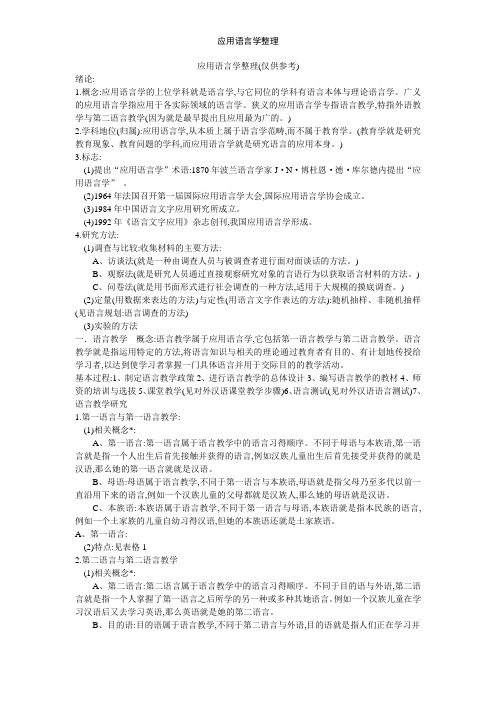
应用语言学整理(仅供参考)绪论:1.概念:应用语言学的上位学科就是语言学,与它同位的学科有语言本体与理论语言学。
广义的应用语言学指应用于各实际领域的语言学。
狭义的应用语言学专指语言教学,特指外语教学与第二语言教学(因为就是最早提出且应用最为广的。
)2.学科地位(归属):应用语言学,从本质上属于语言学范畴,而不属于教育学。
(教育学就是研究教育现象、教育问题的学科,而应用语言学就是研究语言的应用本身。
)3.标志:(1)提出“应用语言学”术语:1870年波兰语言学家J·N·博杜恩·德·库尔德内提出“应用语言学”。
(2)1964年法国召开第一届国际应用语言学大会,国际应用语言学协会成立。
(3)1984年中国语言文字应用研究所成立。
(4)1992年《语言文字应用》杂志创刊,我国应用语言学形成。
4.研究方法:(1)调查与比较:收集材料的主要方法:A、访谈法(就是一种由调查人员与被调查者进行面对面谈话的方法。
)B、观察法(就是研究人员通过直接观察研究对象的言语行为以获取语言材料的方法。
)C、问卷法(就是用书面形式进行社会调查的一种方法,适用于大规模的摸底调查。
)(2)定量(用数据来表达的方法)与定性(用语言文字作表达的方法):随机抽样、非随机抽样(见语言规划:语言调查的方法)(3)实验的方法一.语言教学---概念:语言教学属于应用语言学,它包括第一语言教学与第二语言教学。
语言教学就是指运用特定的方法,将语言知识与相关的理论通过教育者有目的、有计划地传授给学习者,以达到使学习者掌握一门具体语言并用于交际目的的教学活动。
基本过程:1、制定语言教学政策2、进行语言教学的总体设计3、编写语言教学的教材4、师资的培训与选拔5、课堂教学(见对外汉语课堂教学步骤)6、语言测试(见对外汉语语言测试)7、语言教学研究1.第一语言与第一语言教学:(1)相关概念*:A、第一语言:第一语言属于语言教学中的语言习得顺序。
语言学课程学习总结研究语言结构和语言变化的基本理论

语言学课程学习总结研究语言结构和语言变化的基本理论语言学是研究语言的科学,它涉及语言的结构、功能和语言的演化变化等方面。
在语言学课程的学习过程中,我们通过学习一些基本的理论和方法,能够更好地理解和分析语言的本质和特点。
本文将对这些学习内容进行总结和研究。
一、语言结构的基本理论1.1 语音学语音学是语言学的一个重要分支,主要研究各种语言中声音的产生、传播和感知等方面。
通过学习语音学理论,我们了解到不同语言中的语音系统存在差异,而这些差异是由语音的音素和音韵规则所决定的。
比如,汉语中的拼音系统采用了声母和韵母的结构,而英语则使用了辅音和元音的组合。
了解语音学理论有助于我们正确发音和分析语音的规则。
1.2 语法学语法学是研究语言中句子的结构和规则的学科,它包括句法、短语结构、语义和语用等方面内容。
通过学习语法学理论,我们能够了解不同语言句子的构成和运作机制。
例如,汉语的语序通常是主语-谓语-宾语的结构,而英语的语序则是主语-谓语-宾语的结构。
语法学的学习使我们能够更准确地理解句子的结构和意义。
1.3 语义学语义学是研究语言意义的学科,它涉及语言单位和语言使用者之间的意义关系。
通过学习语义学理论,我们了解到语言单位的内涵和外延,以及语义关系的建立和扩展。
例如,词汇的语义包括字面意义和隐喻意义,而句子的语义则通过逻辑关系和上下文推断来确立。
语义学的学习使我们能够更准确地理解语言的意义和表达。
二、语言变化的基本理论2.1 语音变化语音变化是指语言系统中的声音规则和发音方式发生的变化。
通过学习语音变化的理论,我们了解到语言的发展过程中声音的演变是如何发生的。
例如,英语中的大量元音变音规律(Great Vowel Shift)是英语发音历史中的重要变化之一。
了解语音变化的理论使我们能够更好地理解和分析语言的演变过程。
2.2 语法变化语法变化是指语言中句法结构和语法规则随着时间的推移而发生的变化。
通过学习语法变化的理论,我们了解到语言的意义结构是如何随着社会和文化环境的改变而发生变化的。
语言运用知识点总结
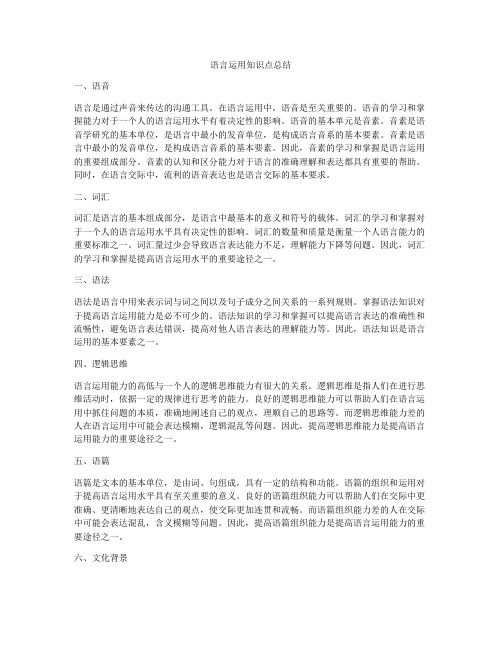
语言运用知识点总结一、语音语言是通过声音来传达的沟通工具。
在语言运用中,语音是至关重要的。
语音的学习和掌握能力对于一个人的语言运用水平有着决定性的影响。
语音的基本单元是音素。
音素是语音学研究的基本单位,是语言中最小的发音单位,是构成语言音系的基本要素。
音素是语言中最小的发音单位,是构成语言音系的基本要素。
因此,音素的学习和掌握是语言运用的重要组成部分。
音素的认知和区分能力对于语言的准确理解和表达都具有重要的帮助。
同时,在语言交际中,流利的语音表达也是语言交际的基本要求。
二、词汇词汇是语言的基本组成部分,是语言中最基本的意义和符号的载体。
词汇的学习和掌握对于一个人的语言运用水平具有决定性的影响。
词汇的数量和质量是衡量一个人语言能力的重要标准之一。
词汇量过少会导致语言表达能力不足,理解能力下降等问题。
因此,词汇的学习和掌握是提高语言运用水平的重要途径之一。
三、语法语法是语言中用来表示词与词之间以及句子成分之间关系的一系列规则。
掌握语法知识对于提高语言运用能力是必不可少的。
语法知识的学习和掌握可以提高语言表达的准确性和流畅性,避免语言表达错误,提高对他人语言表达的理解能力等。
因此,语法知识是语言运用的基本要素之一。
四、逻辑思维语言运用能力的高低与一个人的逻辑思维能力有很大的关系。
逻辑思维是指人们在进行思维活动时,依据一定的规律进行思考的能力。
良好的逻辑思维能力可以帮助人们在语言运用中抓住问题的本质,准确地阐述自己的观点,理顺自己的思路等。
而逻辑思维能力差的人在语言运用中可能会表达模糊,逻辑混乱等问题。
因此,提高逻辑思维能力是提高语言运用能力的重要途径之一。
五、语篇语篇是文本的基本单位,是由词、句组成,具有一定的结构和功能。
语篇的组织和运用对于提高语言运用水平具有至关重要的意义。
良好的语篇组织能力可以帮助人们在交际中更准确、更清晰地表达自己的观点,使交际更加连贯和流畅。
而语篇组织能力差的人在交际中可能会表达混乱,含义模糊等问题。
应用语言学专题课程总结
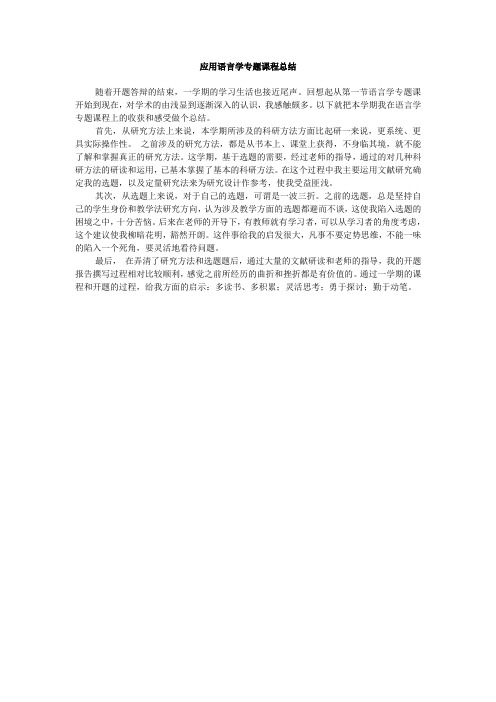
应用语言学专题课程总结
随着开题答辩的结束,一学期的学习生活也接近尾声。
回想起从第一节语言学专题课开始到现在,对学术的由浅显到逐渐深入的认识,我感触颇多。
以下就把本学期我在语言学专题课程上的收获和感受做个总结。
首先,从研究方法上来说,本学期所涉及的科研方法方面比起研一来说,更系统、更具实际操作性。
之前涉及的研究方法,都是从书本上、课堂上获得,不身临其境,就不能了解和掌握真正的研究方法。
这学期,基于选题的需要,经过老师的指导,通过的对几种科研方法的研读和运用,已基本掌握了基本的科研方法。
在这个过程中我主要运用文献研究确定我的选题,以及定量研究法来为研究设计作参考,使我受益匪浅。
其次,从选题上来说,对于自己的选题,可谓是一波三折。
之前的选题,总是坚持自己的学生身份和教学法研究方向,认为涉及教学方面的选题都避而不谈,这使我陷入选题的困境之中,十分苦恼。
后来在老师的开导下,有教师就有学习者,可以从学习者的角度考虑,这个建议使我柳暗花明,豁然开朗。
这件事给我的启发很大,凡事不要定势思维,不能一味的陷入一个死角,要灵活地看待问题。
最后,在弄清了研究方法和选题题后,通过大量的文献研读和老师的指导,我的开题报告撰写过程相对比较顺利,感觉之前所经历的曲折和挫折都是有价值的。
通过一学期的课程和开题的过程,给我方面的启示:多读书、多积累;灵活思考;勇于探讨;勤于动笔。
应用语言学课程总结

应用语言学课程总结
应用语言学课程总结
应用语言学是一门研究语言使用的科学,它涉及了语言的各个方面,如语音、语法、词汇、语用等。
本次课程主要介绍了应用语言学的基本概念和相关研究方法,让我们对这门学科有了更深入的认识。
在本次课程中,我们首先学习了应用语言学的概念和历史背景。
应用语言学是一门跨学科的研究领域,它涵盖了很多其他领域的知识,如心理学、社会学、计算机科学等。
同时,我们也了解到了应用语言学在现代社会中的重要性和广泛应用。
其次,我们深入探讨了一些常见的应用语言学问题。
例如,在口译和笔译中如何处理文化差异问题;在跨文化交际中如何避免误解;在商务沟通中如何运用得体的礼仪等等。
通过这些案例分析,我们进一步认识到了应用语言学的实际意义。
除此之外,本次课程还介绍了一些常见的研究方法和工具。
例如,问卷调查、实验研究、语料库分析等。
这些方法和工具可以帮助我们更加科学地研究语言使用的现象,提高我们的研究水平和能力。
在本次课程的学习过程中,我们还进行了一些小组讨论和个人演讲。
这些活动不仅有助于我们更好地理解课程内容,还锻炼了我们的表达能力和团队合作精神。
通过本次课程的学习,我深刻认识到了应用语言学在现代社会中的重要性和广泛应用。
同时,我也掌握了一些常见的研究方法和工具,为今后的学习和工作打下了坚实的基础。
总之,本次应用语言学课程内容丰富、形式多样、实用性强。
希望今后能够继续深入学习这门科学,为推动人类语言使用领域的发展做出自己的贡献。
应用语言学课程总结

应用语言学课程总结1. 介绍应用语言学是一门综合性的学科,它研究语言与社会、文化、认知等领域的关系,并探讨如何将语言学原理应用于实际问题的解决。
在应用语言学课程中,我们深入学习了语言学的各个方面,并了解了如何将所学知识应用于实际场景中。
2. 语言与社会2.1 语言变体与社会地位在这部分内容中,我们学习了不同区域、社会群体以及社会地位对语言变体的影响。
社会因素如年龄、性别、职业、教育水平等与语言变体之间存在着紧密的联系。
通过对语言变体的研究,我们可以了解不同社会群体的身份认同与文化特征。
2.1.1 美国英语的社会变体•标准美国英语(Standard American English,SAE)•非标准美国英语(Non-Standard American English,NSAE)2.1.2 社会地位与语言变体•上层社会地位对语言的影响•下层社会地位对语言的影响2.2 语言政策与规划语言政策与规划涉及到政府、教育机构等各个层面的决策与干预,以推动语言的使用、保护和发展。
2.2.1 单一语言政策 vs 多元语言政策•单一语言政策:强调使用一种主流语言,常见于许多国家的官方政策。
•多元语言政策:尊重并鼓励多种语言的使用,旨在维护语言多样性和文化多样性。
2.2.2 语言规划的目标和策略•语言使用目标:如提高母语使用水平、推广官方语言等。
•语言保护目标:如保护濒危语言、少数民族语言等。
•语言发展目标:如促进新兴方言的发展、推动语言技能的提升等。
3. 语言与认知3.1 语言与思维过程语言与思维密切相关,两者相互影响、相互促进。
3.1.1 语言对思维的影响•不同语言的表达方式对思维的影响。
•语言对逻辑推理和问题解决能力的影响。
3.1.2 思维对语言的影响•思维方式对语言结构和语义的影响。
•文化差异对思维方式和语言的影响。
3.2 语言习得与认知发展语言习得是指儿童在成长过程中自然获得母语的过程。
语言习得与认知发展密切相关。
应用语言学总结
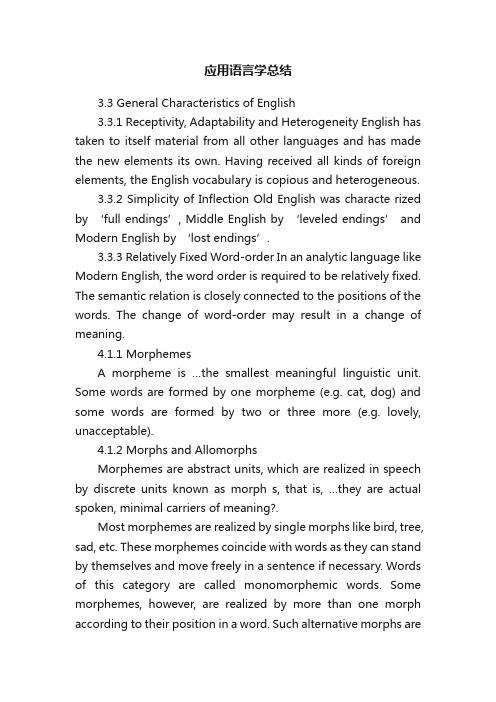
应用语言学总结3.3 General Characteristics of English3.3.1 Receptivity, Adaptability and Heterogeneity English has taken to itself material from all other languages and has made the new elements its own. Having received all kinds of foreign elements, the English vocabulary is copious and heterogeneous.3.3.2 Simplicity of Inflection Old English was characte rized by ‘full endings’, Middle English by ‘leveled endings’ and Modern English by ‘lost endings’.3.3.3 Relatively Fixed Word-order In an analytic language like Modern English, the word order is required to be relatively fixed. The semantic relation is closely connected to the positions of the words. The change of word-order may result in a change of meaning.4.1.1 MorphemesA morpheme is …the smallest meaningful linguistic unit. Some words are formed by one morpheme (e.g. cat, dog) and some words are formed by two or three more (e.g. lovely, unacceptable).4.1.2 Morphs and AllomorphsMorphemes are abstract units, which are realized in speech by discrete units known as morph s, that is, …they are actual spoken, minimal carriers of meaning?.Most morphemes are realized by single morphs like bird, tree, sad, etc. These morphemes coincide with words as they can stand by themselves and move freely in a sentence if necessary. Words of this category are called monomorphemic words. Some morphemes, however, are realized by more than one morph according to their position in a word. Such alternative morphs areknown as allomorph s or morphemic variants. They are the variants of the same morpheme. For instance, the morpheme of plurality {-s} has a number of allomorphs in different sound context, e.g. in cats /s/, in bags /z/, in matches /iz/.6.1.3 Two Processes of DevelopmentThe development of word-meaning from monosemy to polysemy follows two courses which are called radiation and concatenation.1) RadiationIt is a semantic process in which the primary meaning stands at the centre and the secondary meanings proceed out of it in every direction like rays. The meaninng are independent of one another ,but can all be traced back to the central meaning2) ConcatenationC oncatenation, literally meaning …linking together?, is the semantic process in which the meaning of a word moves gradually away from its firstsignification by successive shifts of meanings until, in many cases, there is not a shadow of connection between the sense that is finally developed and that which the term had in it at the outset .Unlike radiation where each of the derived meaning is directly connected to the primary meaning,Concatenation describes a process where each of the later meaning is related only to the preceding one like chains.Radiation is concatenation is closely related, being different stages of the development leadingto polysemy..The two processes work together,complementing each other.(2) AffixesAffixes are linguistic fragments that are attached to words or word elements to modify meaning or change function. According to the functions of affixes, we can put them into two groups: inflectional and derivational affixes.a. Inflectional AffixesThey are affixes attached to the end of words to indicate grammatical relationships, e.g. the regular plural suffix –s (-es); the past tense marker –ed. The number of inflectional affixes is small and stable, which makes English one of the easiest languages to learn.b. Derivational AffixesThey are affixes added to other morphemes to derive new words. They can be further divided into prefixes and suffixes. Prefixes occur before the word and the suffixes after the word.7.1 Types of Meaning Changeextension, narrowing, elevation, degradation, transference, and euphemism.7.1.1 Extension of meaningExtension of meaning, also known as generalization, is the name given to the widening of meaning which some words undergo. It is a process by which a word which originally had a specialized meaning has now become generalized or has extended to cover a broader and often less definite concept, e.g. manuscript7.1.2 Narrowing of MeaningNarrowing of meaning, also called specialization, is the opposite of widening meaning. It is a process by which a word of wide meaning acquires a narrower or specialized sense. In other words, a word which used to have a more general sense becomes restricted in its application and conveys a special concept inpresent-day English, e.g. garage7.1.3 Elevation of meaningElevation or amelioration refers to the process by which words rise from humble beginnings to positions of importance,e.g. nice7.1.4 Degradation of MeaningDegradation or pejoration of meaning is the opposite of semantic elevation. It is a process whereby words of good origin or affective neutrality fall into ill reputation or come to be used in a derogatory sense, e.g. boor7.1.5 Transference of MeaningSome words which were used to designate one thing but later changed to mean something else have experienced the process of semantic transfer, known as transference or transfer of meaning. E.g. paper.1)Associated TransferIt is what is commonly known as figurative extension of meaning.2)Transfer between Abstract and Concrete MeaningsRoom formerly meant …space? as in “There is no room in the car”. Now it has developed a concrete meaning as in “This flat has three rooms”.3)Transfer between Subjective and Objective MeaningsSome words were formerly used subjectively but later shifted to an objective use, and the subjective meaning was totally lost,e.g. pitiful.4)SynesthesiaThis kind of transfer takes place between words of sensation. That is, words usually associated with one sense are used to describe another sense, e.g. clear-sounding (from sight tohearing).1.The most common types of word-meaning changes are extension and n_________.(narrowing) 2. Extension of meaning, also known as g________, is the name given to the widening of meaning which some words undergo. (generalization) 3. The associated transfer of meaning and euphemistic use of words etc. are often due to p_________.(psychological factors) 4. Narrowing of meaning is the opposite of e_______meaning.(extension) 5. Words which were uesd to designate one thing but later changed tomean something else have experienced the process of semantic t________. (transfer) 6.Changes of word meaning are due to linguistic factors and e_____factors. (extra-linguistic) 7. Linguistic factors includes internal factors within the language system, the influx of borrowings and (analogy)2.nonresistance, irregular, illogical, unnecessary, impolite, dishonest3.misjudge, misunderstand anti-Japanese, counter-revolution4.-less: endless, selfless, careless5.-en: golden6.-ern: eastern, western7.-able: comfortable, suitable8.-ish: childish, foolish, bookish9.-al: national, cultural10.-ant: significant, pollutant11.-ent: different, independent12.-ous: famous, courageous13.-y: cloudy, rainy, windy14.-ic: heroic,democratic Movable comfortable applicable visible responsible Natural additional educational physicalRepublicanMerciful tactful graceful dutifulMokeyish snobbish nightmarish sixtyish wettish thinnish plum pishPriceless timelessDreamlike animallike ladylike15.bus=omnibus plane=aeroplane mod=modern demo=demonstrationad=advertisement flu=influenza tec=detective16.。
应用语言学实验报告总结

一、实验背景随着全球化的深入发展,应用语言学作为一门跨学科的研究领域,越来越受到广泛关注。
应用语言学实验旨在通过科学的方法,验证和应用语言学理论,以期为语言教学、翻译、跨文化交流等领域提供理论支持和实践指导。
本实验报告总结了我们在应用语言学领域进行的一系列实验,旨在探讨语言教学、翻译策略和跨文化交流等方面的有效方法。
二、实验目的1. 验证和改进现有的语言教学理论;2. 探索有效的翻译策略,提高翻译质量;3. 分析跨文化交流中的障碍,提出解决方案;4. 提高实验者的实验设计、实施和分析能力。
三、实验方法1. 实验一:基于语料库的词汇教学实验实验目的:验证语料库在词汇教学中的有效性。
实验方法:选取一定数量的词汇,分别进行语料库查询和传统教学方法的词汇教学。
对比两组学生在词汇掌握程度、记忆效果和兴趣等方面的差异。
实验结果:语料库教学组学生在词汇掌握程度、记忆效果和兴趣方面均优于传统教学组。
2. 实验二:基于任务型教学的英语写作实验实验目的:探讨任务型教学在英语写作教学中的效果。
实验方法:将学生分为实验组和对照组,实验组采用任务型教学方法,对照组采用传统教学方法。
对比两组学生在写作能力、创新能力和合作意识等方面的差异。
实验结果:实验组学生在写作能力、创新能力和合作意识方面均优于对照组。
3. 实验三:翻译策略对比实验实验目的:验证不同翻译策略对翻译质量的影响。
实验方法:选取一段英文文本,分别采用直译、意译和归化等翻译策略进行翻译。
对比不同翻译策略下的翻译质量。
实验结果:意译策略在翻译质量方面表现最佳,直译和归化策略次之。
4. 实验四:跨文化交流障碍分析实验实验目的:分析跨文化交流中的障碍,并提出解决方案。
实验方法:通过问卷调查、访谈等方式收集跨文化交流中的障碍信息,分析障碍产生的原因,提出相应的解决方案。
实验结果:跨文化交流中的障碍主要包括文化差异、语言障碍、沟通方式等。
针对这些障碍,我们提出以下解决方案:加强跨文化培训、提高语言能力、采用有效的沟通方式等。
应用语言学整理
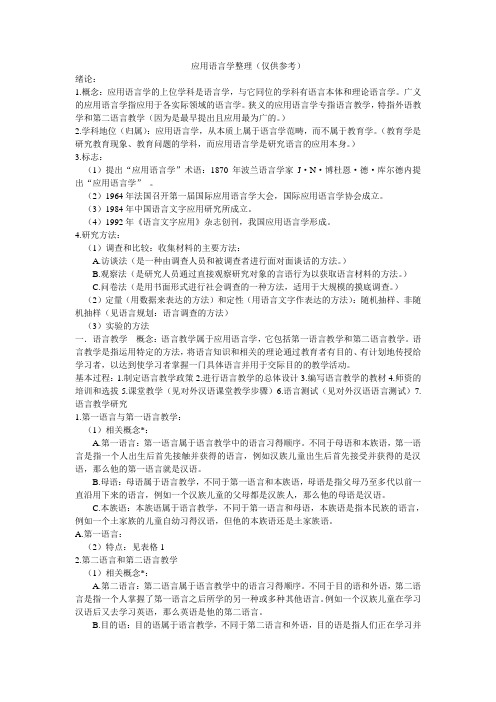
应用语言学整理(仅供参考)绪论:1.概念:应用语言学的上位学科是语言学,与它同位的学科有语言本体和理论语言学。
广义的应用语言学指应用于各实际领域的语言学。
狭义的应用语言学专指语言教学,特指外语教学和第二语言教学(因为是最早提出且应用最为广的。
)2.学科地位(归属):应用语言学,从本质上属于语言学范畴,而不属于教育学。
(教育学是研究教育现象、教育问题的学科,而应用语言学是研究语言的应用本身。
)3.标志:(1)提出“应用语言学”术语:1870年波兰语言学家J·N·博杜恩·德·库尔德内提出“应用语言学”。
(2)1964年法国召开第一届国际应用语言学大会,国际应用语言学协会成立。
(3)1984年中国语言文字应用研究所成立。
(4)1992年《语言文字应用》杂志创刊,我国应用语言学形成。
4.研究方法:(1)调查和比较:收集材料的主要方法:A.访谈法(是一种由调查人员和被调查者进行面对面谈话的方法。
)B.观察法(是研究人员通过直接观察研究对象的言语行为以获取语言材料的方法。
)C.问卷法(是用书面形式进行社会调查的一种方法,适用于大规模的摸底调查。
)(2)定量(用数据来表达的方法)和定性(用语言文字作表达的方法):随机抽样、非随机抽样(见语言规划:语言调查的方法)(3)实验的方法一.语言教学---概念:语言教学属于应用语言学,它包括第一语言教学和第二语言教学。
语言教学是指运用特定的方法,将语言知识和相关的理论通过教育者有目的、有计划地传授给学习者,以达到使学习者掌握一门具体语言并用于交际目的的教学活动。
基本过程:1.制定语言教学政策2.进行语言教学的总体设计3.编写语言教学的教材4.师资的培训和选拔5.课堂教学(见对外汉语课堂教学步骤)6.语言测试(见对外汉语语言测试)7.语言教学研究1.第一语言与第一语言教学:(1)相关概念*:A.第一语言:第一语言属于语言教学中的语言习得顺序。
应用语言学要点总结

名词解释1、个别语言学:属于本体语言学,就是探讨一种语言的结构与发展规律。
如:汉语语言学,英语语言学。
普通语言学:就是研究人类语言一般的性质与普遍的性质及普遍的结构规律的学科。
由于讨论的就是对各种具体语言有普遍指导意义的理论,又被称为理论语言学。
2、共时语言学:又称“描写语言学”,就是指选取语言的某一个历史阶段,描写这个阶段的语言的状态。
如:现代汉语、先秦汉语。
历时语言学:又称“历史语言学”,它研究语言的发展变化。
如:汉语史。
3、自然语言处理:就是运用计算机技术来研究、处理自然语言的交叉性学科。
主要目标就是让计算机懂得与理解人的自然语言,实现人机对话。
中文信息处理:就是自然语言信息处理的下位概念,就是指用计算机对中文进行存储、转换、分析、传输等加工,以形成各种信息处理系统的科学。
4、语言能力:传统上指运用语言进行听说读写的能力或指用书面或口语进行交际的能力。
(如:语音能力、词汇能力、语法能力。
)从而规范地、正确地使用语言。
语言交际能力:说话者适应交际主体、主旨、语境,有效地进行言语交际的能力。
即更加得体、有效地使用语言的能力。
5、对比分析:就就是把两种或两种以上的语言或方言进行共时对比,描述她们之间的异同。
目的就是由此找出目标语学习者的学习难点,以便于最有效的方法来组织教学。
偏误分析:指对学生在第二语言学习中所产生的偏误进行分析,进而研究第二语言的学习过程。
它就是研究学习过程的捷径,也就是研究学习过程的第一步。
简答题1、语言学与其她学科的联系导致一系列新兴的交叉学科的建立,主要就是有哪些?(1)、社会语言学:用社会学的方法研究社会上的各种语言变异等问题。
(2)、人类语言学:研究语言所反映的民族文化及其演变情况。
(3)、心理语言学:研究语言行为与心理过程之间的关系。
(4)、数理语言学:用代数,计算机科学,统计等领域中国的概念与方法研究语言的数学属性等问题。
(5)、实验语言学:用各种实验仪器分析语音,研究语音的识别与合成等问题。
语言学概论课程学习成效报告

语言学概论课程学习成效报告摘要:本文是对语言学概论课程学习成效的报告。
通过学习该课程,我对语言学的基本概念、理论和方法有了全面的了解,并且在实践中获得了应用的机会。
本文将从课程内容的学习效果、实践能力的提升以及对未来学习和研究的影响这三个方面进行详细阐述。
1. 课程内容的学习效果语言学概论课程主要涵盖了语言学的基本理论、研究方法、语音学、语法学、语义学等内容。
通过系统学习,我对这些基本概念和理论有了比较清晰的认识。
在每个模块的学习中,我通过阅读教材、参与讨论和完成作业等方式逐渐建立了对语言学的整体认识。
同时,通过课堂上的案例分析和实例讲解,我对语言学理论的实际应用有了更深入的了解。
2. 实践能力的提升在课程中,我参与了一些实践项目,如语音学实验、实地调研和语料库分析等。
这些实践活动培养了我对语言学理论的运用能力,提高了我在语言学研究和实践中的能力。
在语音学实验中,我学习了采集和分析语音数据的基本方法,并通过实际操作提升了实验技能。
通过实地调研和语料库分析,我深入了解了语言实际运用中的问题,并掌握了一些调查和分析方法。
这些实践经验对我今后的学术研究和职业发展具有重要意义。
3. 对未来学习和研究的影响语言学概论课程为我今后深入学习和研究语言学奠定了坚实基础。
通过学习该课程,我不仅了解了语言学的基本概念和理论,还了解了语言学的发展动态和研究前沿。
这对于我今后继续学习相关课程和开展研究具有重要启发作用。
同时,在实践中获得的能力和经验也为我提供了更多的研究和实践机会,使我能够更好地应对未来的学习和研究挑战。
总结:通过学习语言学概论课程,我对语言学的基本概念、理论和方法有了全面的了解,并通过实践活动提升了相关能力。
这门课程对我今后的学习和研究具有重要影响,为我今后的学术发展奠定了坚实基础。
通过不断努力学习和实践,我相信我能在语言学领域取得更大的成就。
- 1、下载文档前请自行甄别文档内容的完整性,平台不提供额外的编辑、内容补充、找答案等附加服务。
- 2、"仅部分预览"的文档,不可在线预览部分如存在完整性等问题,可反馈申请退款(可完整预览的文档不适用该条件!)。
- 3、如文档侵犯您的权益,请联系客服反馈,我们会尽快为您处理(人工客服工作时间:9:00-18:30)。
应用语言学课程总结
《应用语言学》课程学期末教师课程总结
亲爱的同学们:
在过去的一个学期里,我们一起经历了《应用语言学》这门课程
的学习。
通过这门课程,我们深入探讨了语言学在实际应用中的重要性,学习了一些基本的应用语言学原理和方法。
在这个学期的学习过
程中,我感到非常欣慰和骄傲,因为你们展现了出色的学习态度和出
色的学术表现。
我们一起探讨了语言学的基本概念和理论,包括语音学、语法学、语义学和语用学。
我们通过学习这些理论,帮助大家了解了语言的结
构和功能,并让你们认识到语言是与我们日常生活紧密相关的。
我们
也关注了语言变异和多样性的现象,通过研究方言、社会语言学以及
跨文化交际等内容,拓宽了对语言学的视野。
我们重点学习了应用语言学在现实生活中的具体应用。
通过研究
和分析不同情境下的语言使用,我们了解了语言如何影响和塑造人们
的行为、思维和社会互动。
我们探讨了语言与教育、医学、广告和媒
体等领域之间的联系,并学习了应用语言学的研究方法和技巧。
在这个学期的学习过程中,你们展现了积极的学习态度和出色的
学术表现。
你们在课堂上积极参与讨论,主动提出问题和分享观点。
在小组作业和个人项目中,你们展示了扎实的研究能力和创新思维。
你们通过实践,将所学知识应用到实际生活中,为课程增添了更多的
想象力和创造力。
然而,学习永远是一个不断进步的过程。
在下一个学期的课程中,我们将继续深入探讨应用语言学的各个领域,并进一步提升我们的学
术能力和研究方法。
我鼓励大家在独立思考和团队合作方面继续努力,挖掘出更多的学术成果和应用机会。
我要感谢大家在整个学期里的辛勤付出和支持。
你们的热情和努
力使这门课程充满了活力和创意。
我相信,通过这门课程的学习,你们将更好地理解和应用语言学的知识,为将来的学习和职业发展打下坚实的基础。
祝大家在未来的学习和生活中,继续保持对语言学的热爱和探索精神!
教师。
